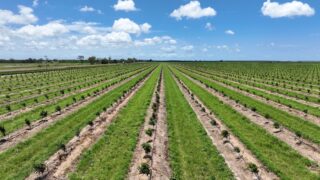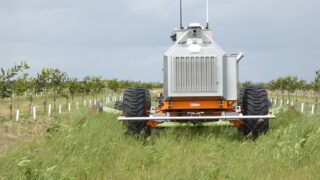Thought leadership
- Date 16 October 2025
- Words by Dáire Brady
- Reading time 3 mins
Feeding the Future: Investing in the Natural Capital That Sustains Us
Every year on 16 October, we celebrate World Food Day. This year marks a particularly meaningful milestone - eighty years since the Food and Agriculture Organization (FAO) was founded in 1945 as part of the post-war settlement.
Introduction: The Paradox of Abundance
Every year on 16 October, we celebrate World Food Day. This year marks a particularly meaningful milestone – eighty years since the Food and Agriculture Organization (FAO) was founded in 1945 as part of the post-war settlement.
World Food Day 2025 calls for global collaboration to create a peaceful, sustainable, prosperous, and food-secure future. As the FAO notes:
“By working together, across governments, organizations, sectors, and communities, we can transform agrifood systems to ensure that everyone has access to a healthy diet, living in harmony with the planet.”
The theme resonates strongly with Climate Asset Management’s mission. We seek to scale regenerative and impactful farming systems, transforming land management through partnerships with local stakeholders to deliver healthy, nutritious, and sustainable food within our chosen value chains.
At Climate Asset Management, we believe the path to long-term food security lies not just in producing more, but in producing better: regenerating the natural capital that sustains agricultural productivity, resilience, and livelihoods.
State of the Food and Agriculture Industry Today
The global food and agriculture sector is at an inflection point – shaped by climate volatility, shifting consumer demand, input-cost inflation, and tightening resource limits.
- Agrifood systems remain a major contributor to global greenhouse-gas emissions, and their exposure to climate and weather extremes is intensifying.[1] Droughts, floods, and heat events are reducing yields in key producing regions from Southern Europe to Southeast Asia.[2]
- Input costs and supply chain fragility have redefined production economics. Fertiliser, energy, and logistics shocks since 2022 have driven lasting margin pressure across crop and protein systems.[3]
- Water stress is becoming a dominant constraint: more than 40 percent of global agricultural land now operates under medium-to-high water stress conditions, forcing rapid adaptation in irrigation and cropping systems.[4]
- Dietary shifts and traceability expectations are accelerating structural change. Global demand for sustainably produced, plant-forward, and nutrient-dense foods continues to rise, creating premium market segments and new value chains.[5]
These forces highlight a fundamental re-pricing of food and land – from cyclical commodities to systemic, real assets essential for resilience, nutrition, and climate stability.
The Natural Capital Foundation of Food Systems

Agriculture depends fundamentally on soil health, water availability, biodiversity, and climate stability – the four pillars of natural capital. Yet, traditional extractive models have eroded these foundations:
- Over 30% of soils globally are degraded.[6]
- 70% of freshwater withdrawals are for agriculture.[7]
- One-third of global greenhouse gas emissions are tied to food systems.[8]
Our work focuses on restoring these natural capital foundations – rebuilding soil carbon, improving water use efficiency, and integrating biodiversity corridors – so that farms and landscapes can produce nutritious food and positive ecological outcomes.
Regenerative Agriculture as a Scalable Solution
Transitioning to regenerative systems – where natural processes are restored rather than depleted – has evolved from pilot projects to institutional-scale investment strategies.
As institutional capital flows increasingly toward regenerative agriculture, consistent performance trends are emerging:

- Improved yield stability through enhanced soil-moisture retention;
- Reduced input dependency as soil biology replaces synthetic fertilisers;
- Increased carbon sequestration and biodiversity, generating new revenue streams through ecosystem-service credits.[9]
These benefits compound over time, creating resilient supply chains and long-term value for investors, farmer-operators, and ecosystems alike.
Aligning Capital with Regenerative Food Systems
Institutional investors are increasingly allocating capital to the natural capital asset class, recognising both its long-term resilience and its role in climate and food-system stability.
According to the Climate Policy Initiative, closing the global finance gap for sustainable agrifood systems will require an additional USD 1 trillion per year.[10]
Our strategies deploy capital into scalable, nature-positive farmland systems – from macadamia orchards in Australia to almond and pistachio portfolios in Iberia – embedding regenerative practices, local partnerships, and ecological benefit value stacking from the outset.
Sources:
[1] Intergovernmental Panel on Climate Change (IPCC) (2023) Sixth Assessment Report (AR6): Mitigation of Climate Change – Chapter 7: Agriculture, Forestry and Other Land Use (A F O L U). Geneva: IPCC.
[2] Food and Agriculture Organization of the United Nations (FAO) and World Meteorological Organization (WMO) (2024) State of Global Agriculture and Climate Resilience Report 2024. Rome: FAO/WMO.
[3] Organisation for Economic Co-operation and Development (OECD) and FAO (2024) Agricultural Outlook 2024–2033. Paris: OECD Publishing.
[4] Food and Agriculture Organization of the United Nations (FAO) (2023) The State of the World’s Land and Water Resources for Food and Agriculture – Systems at Breaking Point. Rome: FAO.
[5] World Economic Forum (WEF) (2024) Future of Food and Agriculture Report 2024: Scaling Sustainable Consumption and Traceability. Geneva: WEF.
[6] Food and Agriculture Organization of the United Nations (FAO) (2023) Soil degradation and sustainable management. Rome: FAO. Available at: https://www.fao.org/soils-portal/soil-degradation-restoration/en/
[7] Food and Agriculture Organization of the United Nations (FAO) (2024) AQUASTAT – FAO’s Global Information System on Water and Agriculture. Rome: FAO. Available at: https://www.fao.org/aquastat/en/
[8] Intergovernmental Panel on Climate Change (IPCC) (2023) Sixth Assessment Report (AR6): Mitigation of Climate Change – Chapter 7: Agriculture, Forestry and Other Land Use (AFOLU). Geneva: IPCC. Available at: https://www.ipcc.ch/report/ar6-wg3/
[9] United Nations Environment Programme Finance Initiative (UNEP FI) (2023) Driving Finance for Sustainable Food Systems: A Guide for Financial Institutions. Geneva: UNEP FI. Available at: https://www.unepfi.org/publications/driving-finance-for-sustainable-food-systems/
[10] Climate Policy Initiative (2024) New report reveals USD 1 trillion gap in annual finance for agrifood systems. Available at: https://www.climatepolicyinitiative.org/press-release/new-report-reveals-usd-1-trillion-gap-in-annual-finance-for-agrifood-systems/
Disclaimer: This article is based on Climate Asset Management’s Investment team views and is provided for general information purposes only. It does not constitute investment advice or policy guidance.

